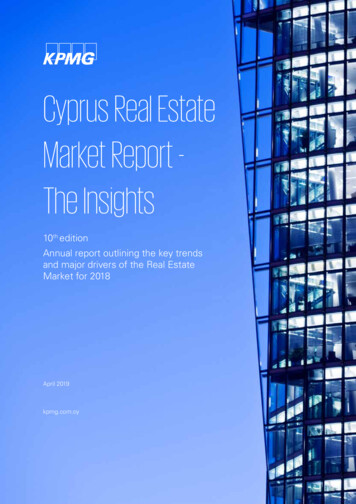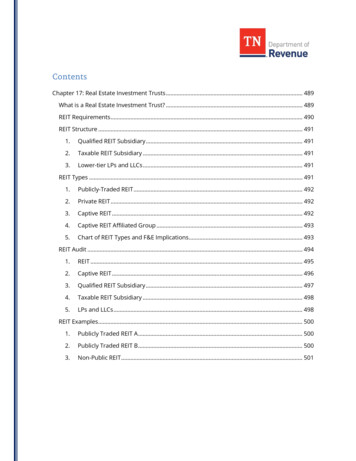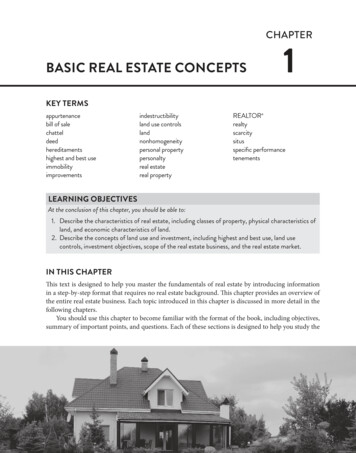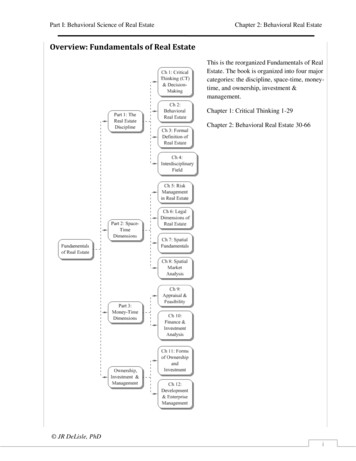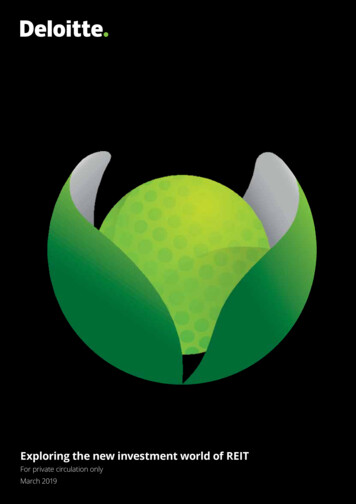
Transcription
ch26 p739 765.qxp12/8/112:04 PMPage 739CHAPTER26Valuing Real Estatehe valuation models developed for financial assets are applicable for real assets as well. Real estate investments comprise the most significant componentof real asset investments. For many years, analysts in real estate have used theirown variants on valuation models to value real estate. Real estate is too differentan asset class, they argue, to be valued with models developed to value publiclytraded stocks.This chapter presents a different point of view: that while real estate and stocksmay be different asset classes, the principles of valuation should not differ acrossthe classes. In particular, the value of real estate property should be the presentvalue of the expected cash flows on the property. That said, there are serious estimation issues to confront that are unique to real estate and that will be dealt with inthis chapter.TREAL VERSUS FINANCIAL ASSETSReal estate and financial assets share several common characteristics: Their value isdetermined by the cash flows they generate, the uncertainty associated with thesecash flows, and the expected growth in the cash flows. Other things remainingequal, the higher the level and growth in the cash flows, and the lower the risk associated with the cash flows, the greater is the value of the asset.There are also significant differences between the two classes of assets. Thereare many who argue that the risk and return models used to evaluate financial assetscannot be used to analyze real estate because of the differences in liquidity acrossthe two markets and in the types of investors in each market. The alternatives totraditional risk and return models will be examined in this chapter. There are alsodifferences in the nature of the cash flows generated by financial and real estate investments. In particular, real estate investments often have finite lives, and have tobe valued accordingly. Many financial assets, such as stocks, have infinite lives.These differences in asset lives manifest themselves in the value assigned to these assets at the end of the estimation period. The terminal value of a stock, 5 or 10 yearshence, is generally much higher than the current value because of the expectedgrowth in the cash flows, and because these cash flows are expected to continue forever. The terminal value of a building may be lower than the current value becausethe usage of the building might depreciate its value. However, the land componentwill have an infinite life and, in some cases, may be the overwhelming component ofthe terminal value.739
ch26 p739 765.qxp12/8/112:04 PMPage 740740VALUING REAL ESTATETHE EFFECT OF INFLATION: REAL VERSUS FINANCIAL ASSETSFor the most part, real and financial assets seem to move together in responseto macroeconomic variables. A downturn in the economy seems to affect bothadversely, as does a surge in real interest rates. There is one variable, though,that seems to have dramatically different consequences for real and financialassets, and that is inflation. Historically, higher than anticipated inflation hashad negative consequences for financial assets, with both bonds and stocksbeing adversely impacted by unexpected inflation. Fama and Schwert, for instance, in a study on asset returns report that a 1 percent increase in the inflation rate causes bond prices to drop by 1.54 percent and stock prices by 4.23percent. In contrast, unanticipated inflation seems to have a positive impacton real assets. In fact, the only asset class that Fama and Schwert tracked thatwas positively affected by unanticipated inflation was residential real estate.Why is real estate a potential hedge against inflation? There are a varietyof reasons, ranging from more favorable tax treatment when it comes to depreciation to the possibility that investors lose faith in financial assets when inflation runs out of control and prefer to hold real assets. More importantly, thedivergence between real estate and financial assets in response to inflation indicates that the risk of real estate will be very different if viewed as part of a portfolio that includes financial assets than if viewed as a standalone investment.DISCOUNTED CASH FLOW VALUATIONThe value of any cash-flow-producing asset is the present value of the expected cashflows on it. Just as discounted cash flow valuation models, such as the dividend discount model, can be used to value financial assets, they can also be used to valuecash-flow-producing real estate investments.To use discounted cash flow valuation to value real estate investments it is necessary to: Measure the riskiness of real estate investments, and estimate a discount ratebased on the riskiness. Estimate expected cash flows on the real estate investment for the life of the asset.The following section examines these issues.Estimating Discount RatesChapters 6 and 7 presented the basic models that are used to estimate the costs ofequity, debt, and capital for an investment. Do those models apply to real estate aswell? If so, do they need to be modified? If not, what do we use instead?This section examines the applicability of risk and return models to real estateinvestments. In the process, we consider whether the assumption that the marginalinvestor is well diversified is a justifiable one for real estate investments, and, if so,how best to measure the parameters of the model—risk-free rate, beta, and risk
ch26 p739 765.qxp12/8/112:04 PMPage 741Discounted Cash Flow Valuation741premium—to estimate the cost of equity. We also consider other sources of risk inreal estate investments that are not adequately considered by traditional risk andreturn models and how to incorporate these into valuation.Cost of Equity The two basic models used to estimate the cost of equity for financial assets are the capital asset and the arbitrage pricing models. In both models, therisk of any asset, real or financial, is defined to be that portion of that asset’s variance that cannot be diversified away. This nondiversifiable risk is measured by themarket beta in the capital asset pricing model (CAPM) and by multiple factor betasin the arbitrage pricing model (APM). The primary assumptions that both modelsmake to arrive at these conclusions are that the marginal investor in the asset is welldiversified and that the risk is measured in terms of the variability of returns.If one assumes that these models apply for real assets as well, the risk of a realasset should be measured by its beta relative to the market portfolio in the CAPMand by its factor betas in the APM. If we do so, however, we are assuming, as wedid with publicly traded stocks, that the marginal investor in real assets is well diversified.Are the Marginal Investors in Real Estate Well Diversified? Many analysts arguethat real estate requires investments that are so large that investors in it may notbe able to diversify sufficiently. In addition, they note that real estate investmentsrequire localized knowledge, and that those who develop this knowledge chooseto invest primarily or only in real estate. Consequently, they note that the use ofthe capital asset pricing model or the arbitrage pricing model, which assume thatonly nondiversifiable risk is rewarded, is inappropriate as a way of estimating costof equity.There is a kernel of truth to this argument, but it can be countered fairly easilyby noting that: Many investors who concentrate their holdings in real estate do so by choice.They see it as a way of leveraging their specialized knowledge of real estate.Thus, we would view them the same way we view investors who choose tohold only technology stocks in their portfolios. Even large real estate investments can be broken up into smaller pieces, allowing investors the option of holding real estate investments in conjunction withfinancial assets. Just as the marginal investor in stocks is often an institutional investor with theresources to diversify and keep transactions costs low, the marginal investor inmany real estate markets today has sufficient resources to diversify.If real estate developers and private investors insist on higher expected returnsbecause they are not diversified, real estate investments will increasingly be held byreal estate investment trusts, limited partnerships, and corporations, which attractmore diversified investors with lower required returns. This trend is well in place inthe United States and may spread over time to other countries as well.Measuring Risk for Real Assets in Asset Pricing Models Even if it is accepted thatthe risk of a real asset is its market beta in the CAPM, and its factor betas in theAPM, there are several issues related to the measurement and use of these risk
ch26 p739 765.qxp74212/8/112:04 PMPage 742VALUING REAL ESTATEparameters that need to be examined. To provide some insight into the measurement problems associated with real assets, consider the standard approach to estimating betas in the capital asset pricing model for a publicly traded stock. First, theprices of the stock are collected from historical data, and returns are computed on aperiodic basis (daily, weekly, or monthly). Second, these stock returns are regressedagainst returns on a stock index over the same period to obtain the beta. For realestate, these steps are not as straightforward.Individual Assets: Prices and Risk Parameters The betas of individual stocks canbe estimated fairly simply because stock prices are available for extended time periods. The same cannot be said for individual real estate investments. A piece ofproperty does not get bought and sold very frequently, though similar propertiesmight. Consequently, price indexes are available for classes of assets (for example,downtown Manhattan office buildings), and risk parameters can be estimated forthese classes.Even when price indexes are available for classes of real estate investments,questions remain about the comparability of assets within a class (Is one downtown building the same as any other? How does one control for differences inage and quality of construction? What about location?) and about the categorization itself (office buildings versus residential buildings; single-family versusmultifamily residences)?There have been attempts to estimate market indexes and risk parameters forclasses of real estate investments. The obvious and imperfect solution to the nontrading problem in real estate is to construct indexes of real estate investment trusts(REITs), which are traded and have market prices. The reason this might not besatisfactory is because the properties owned by real estate investment trusts maynot be representative of the real estate property market, and the securitization ofreal estate may result in differences between real estate and REIT returns. An alternative index more closely tied to real estate property values is the National Councilof Real Estate Investment Fiduciaries (NCREIF) which estimates annual returns forcommercial property as well as for farmland. Since transactions on individualproperities are infrequent, NCREIF uses appraised values for properties to measurereturns. Finally, Case and Shiller constructed an index using actual transactionprices, rather than appraised values, to estimate the value of residential real estate.Table 26.1 summarizes the returns on real estate indexes, the S&P 500, and an index of bonds.There are several interesting results that emerge from this table. First, not allreal estate series behave the same way. First, returns on REITs seem to have more incommon with returns on the stock market than returns on other real estate indexes.Second, there is high positive serial correlation in many of the real estate return series, especially those based on appraised data. This can be attributed to the smoothing of appraisals that are used in these series.The Market Portfolio In estimating the betas of stocks, we generally use a stockindex as a proxy for the market portfolio. In theory, however, the market portfolio should include all assets in the economy in proportion to their market values.This is of particular significance when the market portfolio is used to estimate therisk parameters of real estate investments. The use of a stock index as the market
ch26 p739 765.qxp12/8/112:04 PMPage 743743Discounted Cash Flow ValuationTABLE 26.1 Returns by Asset ClassAsset ClassSourceof DataPeriodExaminedComputationalRatesBloomberg 1928–2010 Dividend PriceappreciationTreasuryFederal1928–2010 Total returnbondsReserveon 10-yearTreasuryFederal1928–2010 3-month T.BillbillsReserveCorporate Federal1928–2010 Total return onbondsReserveBaa bondEquityFTSE1971–2010 Dividend PriceREITsappreciationMortgageFTSE1971–2010 Dividend PriceREITsappreciationAll REITSFTSE1971–2000 Dividend PriceappreciationCommercial NCREIF1978–2010 Total return,real estateappraisedResidential Case &1987–2010 Transaction pricesreal estateShillerFarmlandNCREIF1978–2010 Total return,appraisedStocksArithmetic Standard GeometricAverage Deviation 11.24%7.44%10.66%portfolio will result in the marginalization1 of real estate investments and the underestimation of risk for these assets.The differences between a stock and an all-asset portfolio can be large because themarket value of real estate investments not included in the stock index is significant.There is also evidence that, historically, real estate investments and stocks do notmove together in reaction to larger economic events. In Table 26.2, we reproduce acorrelation table from Ibbotson and Brinson that measured the correlation betweendifferent asset classes and found that real estate was lightly or negatively correlatedwith financial assets. This was at the core of the advice given to investors in the 1980sand 1990s that adding real estate to a portfolio would produce a better risk/returntradeoff. As noted earlier in this chapter, the differences between real asset and financial asset returns widen when inflation rates change. In fact, three of the five real estate indexes are negatively correlated with stocks, and the other two have lowcorrelations. The advice to diversify by adding real estate to your portfolio may needto be revised in light of the changes to the real estate market in the last three decades.As real estate has been increasingly securitized, there is evidence that real estate as anasset class has started behaving more and more like other financial asset classes(stocks and bonds). Perhaps the best way to bring this home is to use a measurefor equities that we presented in Chapter 7—the implied equity risk premium.1When the beta of an asset is estimated relative to a stock index, the underlying assumptionis that the marginal investor has the bulk of his or her portfolio (97 percent to 98 percent) instocks, and measures risk relative to this portfolio.
ch26 p739 765.qxp12/8/112:04 PMPage 744744VALUING REAL ESTATETABLE 26.2 Correlations across Asset nI&SCREF1.000.790.520.260.060.16 0.040.530.701.000.120.16 0.060.250.010.420.35Home1.000.620.51 0.13 0.220.130.77C&SFarmS&PT-bondsT-bills Inflation1.000.49 0.20 0.54 0.560.561.00 0.10 0.44 0.320.491.000.11 0.07 0.021.000.48 0.171.000.251.00I&S Ibbotson & Siegal; CREF: CREF index; Home: Index of home prices; C&S: Case &Shiller; Farm: Index of farmland prices.Source: Ibbotson and Brinson (1996).In Figure 26.1, we bring together the equity risk premium, the default spread on aBaa rated bond (the risk premium for bonds, and a real estate risk premium, computed by subtracting the risk-free rate from the capitalization rate (a required returnmeasure used by real estate investors). Note that while stock and bond premiumshave always moved together for the most part, the behavior of real estate haschanged dramatically over the last three decades. In the 1980s, real estate risk premiums followed a course completely unrelated to the paths followed by stocks andbonds, which is consistent with the low or negative correlations reported in Table 26.2.Starting in the mid-nineties and accelerating through the last decade, real estate riskpremiums have converged both in magnitude and direction with equity and bond risk8.00%6.00%4.00%2.00%ERP 2.00% 4.00% 6.00% 8.00%FIGURE 26.1 Equity risk Premium, Cap Rates and Bond 0199919981997199619951994199319921990Baa %1980AU: You talkabout thechanging realestate marketin terms of 2decades andlater 3 decades.I've changedthe first mention to 3decades aswell. Okay?Cap Rate Premium
ch26 p739 765.qxp12/8/112:04 PMPage 745Discounted Cash Flow Valuation745premiums. In practical terms, this suggests that not only is the correlation betweenreal estate and financial assets much higher but that the former advice of diversifyingyour portfolio by adding real estate to it may no longer be good advice.While few economists would argue with the value of incorporating real estate investments into the market portfolio, most are stymied by the measurement problems.These problems, while insurmountable until recently, are becoming more solvable asreal estate investments get securitized and traded.Some Practical Solutions If one accepts the proposition that the risk of a real estate investment should be measured using traditional risk and return models, thereare some practical approaches that can be used to estimate risk parameters: The risk of a class of real estate investments can be obtained by regressing returnson the class (using the Ibbotson series, for instance, on commercial and residential property) against returns on a consolidated market portfolio. The primaryproblems with this approach are (1) these returns series are based on smoothedappraisals and may understate the true volatility in the market, and (2) the returns are available only for longer return intervals (annual or quarterly). The risk parameters of traded real estate securities (REITs and MLPs) can beused as a proxy for the risk in real estate investment. The limitations of this approach are that securitized real estate investments may behave differently fromdirect investments and that it is much more difficult to estimate risk parametersfor different classes of real estate investment (unless one can find REITs that restrict themselves to one class of investments, such as commercial property). The demand for real estate is in some cases a derived demand. For instance, thevalue of a shopping mall is derived from the value of retail space, which shouldbe a function of how well retailing is doing as a business. It can be argued, insuch a case, that the risk parameters of a mall should be related to the risk parameters of publicly traded retail stores. Corrections should obviously be madefor differences in operating and financial leverage.Other Risk Factors Does investing in real estate investments expose investors tomore (and different) types of risk than investing in financial assets? If so, how is thisrisk measured, and is it rewarded? The following are some of the issues related to realestate investments that might affect the measurement of risk and expected returns.Diversifiable versus Nondiversifiable Risk As stated earlier, using risk and returnmodels that assume that the marginal investor is well diversified is reasonable eventhough many investors in real estate choose not to be diversified. Part of the justification for this statement is the presence of firms with diversified investors, such as realestate investment trusts and master limited partnerships, in the real estate market. Butwhat if no such investors exist and the marginal investor in real estate is not well diversified? How would we modify our estimates of cost of equity?Chapter 24 examined how to adjust the cost of equity for a private business forthe fact that its owner was not diversified. In particular, we recommended the useof a total beta that reflected not just the market risk but also the extent of nondiversification on the part of the owner:Total beta Market beta/Correlation between owner’s portfolio and the market
ch26 p739 765.qxp12/8/112:04 PMPage 746746VALUING REAL ESTATEThis measure could be adapted to estimate a total beta for private businesses. Forinstance, assume that the marginal investor in commercial real estate has a portfolio that has a correlation of 0.50 with the market and that commercial real estate asa property class has a beta of 0.40. The beta you would use to estimate the cost ofequity for the investment would be 0.80.Total beta 0.40/0.5 0.80Using this higher beta would result in a higher cost of equity and a lower value forthe real estate investment.Lack of Liquidity Another critique of traditional risk measures is that they assume that all assets are liquid (or, at least, that there are no differences in liquidity across assets). Real estate investments are often less liquid than financialassets; transactions occur less frequently, transactions costs are higher, and thereare far fewer buyers and sellers. The less liquid an asset, it is argued, the morerisky it is.The link between lack of liquidity and risk is difficult to quantify for severalreasons. One is that it depends on the time horizon of the investor. An investor whointends to hold long-term will care less about liquidity than one who is uncertainabout his or her time horizon or wants to trade short-term. Another is that it is affected by the external economic conditions. For instance, real estate is much moreliquid during economic booms, when prices are rising, than during recessions,when prices are depressed.The alternative to trying to view the absence of liquidity as an additional riskfactor and building into discount rates is to value the illiquid asset conventionally(as if it were liquid) and then applying a illiquidity discount to it. This is often thepractice in valuing closely held and illiquid businesses and allows for the illiquiditydiscount to be a function of the investor and external economic conditions at thetime of the valuation. The process of estimating the discount was examined in moredetail in Chapter 24.Exposure to Legal Changes The values of all investments are affected by changesin the tax law—changes in depreciation methods and changes in tax rates on ordinary income and capital gains. Real estate investments are particularly exposed tochanges in the tax law, because they derive a significant portion of their value fromdepreciation and tend to be highly levered.Unlike manufacturing or service businesses which can move operations from onelocale to another to take advantage of locational differences in tax rates and other legal restrictions, real estate is not mobile and is therefore much more exposed tochanges in local laws (such as zoning requirements, property taxes, and rent control).The question becomes whether this additional sensitivity to changes in tax andlocal laws is an additional source of risk, and, if so, how this risk should be priced.Again, the answer will depend on whether the marginal investor is diversified notonly across asset classes but also across real estate investments in different locations. For instance, a real estate investor who holds real estate in New York, Miami, Los Angeles, and Houston is less exposed to legal risk than one who holds realestate in only one of these locales. The trade-off, however, is that the localizedknowledge that allows a real estate investor to do well in one market may not carrywell into other markets.
ch26 p739 765.qxp12/8/112:04 PMPage 747Discounted Cash Flow Valuation747Information Costs and Risk Real estate investments often require specific information about local conditions that is difficult (and costly) to obtain. The information is also likely to contain more noise. There are some who argue that thishigher cost of acquiring information and the greater noise in this informationshould be built into the risk and discount rates used to value real estate. This argument is not restricted to real estate. It has been used as an explanation for thesmall stock premium—that is small stocks make higher returns than largerstocks, after adjusting for risk (using the CAPM). Small stocks, it is argued, generally have less information available on them than larger stocks, and the information tends to be more noisy.An Alternative Approach to Estimating Discount Rates: The Survey Approach Theproblems with the assumptions of traditional risk and return models and thedifficulties associated with the measurement of risk for nontraded real assets inthese models have led to alternative approaches to estimating discount rates forthese real estate investments. In the context of real estate, for instance, the costsof equity and capital are often obtained by surveying potential investors in realDIVERSIFICATION IN REAL ESTATE: TRENDS AND IMPLICATIONSAs we look at the additional risk factors—estimation errors, legal and taxchanges, volatility in specific real estate markets—that are often built into discount rates and valuations, the rationale for diversification becomes stronger.A real estate firm that is diversified across holdings in multiple locations willbe able to diversify away some of this risk. If the firm attracts investors whoare diversified into other asset classes, it diversifies away even more risk, thusreducing its exposure to risk and its cost of equity.Inexorably, then, you would expect to see diversified real estate investors—real estate corporations, REITs, and MLPs—drive local real estateinvestors who are not diversified (either across locations or asset classes) outof the market by bidding higher prices for the same properties. If this is true,you might ask, why has it not happened already? There are two reasons.The first is that knowledge of local real estate market conditions is still acritical component driving real estate values, and real estate investors withthis knowledge may be able to compensate for their failure to diversify. Thesecond is that a significant component of real estate success still comes frompersonal connections—to other developers, to zoning boards, and to politicians. Real estate investors with the right connections may be able to getmuch better deals on their investments than corporations bidding for thesame business.As real estate corporations and REITs multiply, you should expect to seemuch higher correlation in real estate prices across different regions and adrop-off in the importance of local conditions. Furthermore, you should alsoexpect to see these firms become much more savvy at dealing with the regulatory authorities in different regions.
ch26 p739 765.qxp74812/8/112:04 PMPage 748VALUING REAL ESTATEestate on what rates of return they would demand for investing in different typesof property investments. In many cases, these surveys will be done in terms ofcapitalization rates, which—as we noted earlier—are just required rates of return in another guise.This approach is justified on the following grounds: These surveys are not based on some abstract models of risk and return (whichmay ignore risk characteristics that are unique to the real estate market) but onwhat actual investors in real want to make as a return. These surveys allow for the estimation of discount rates for specific categoriesof properties (hotels, apartments, etc.) by region, without requiring a dependence on past prices like risk and return models. There are relatively few large investors who invest directly in real estate (ratherthan in securitized real estate). It is therefore feasible to do such a survey.There are, however, grounds for contesting this approach, as well: Surveys, by their very nature, yield different “desired rates of return” for different investors for the same property class. Assuming that a range of desired returns can be obtained for a class of investments, it is not clear where one goesnext. Presumably, those investors who demand returns at the high end of thescale will find themselves priced out of the market, and those whose desired returns are at the low end of the scale will find plenty of undervalued properties.The question of who the marginal investor in an investment should be is notanswered in these surveys. The survey approach bypasses the issue of risk but it does not really eliminateit. Clearly, investors demand the returns that they do on different propertyclasses because they perceive them to have different levels of risk. The survey approach works reasonably well when there are relatively fewand fairly homogeneous investors in the market. While this might have beentrue a decade ago, it is becoming less so as new institutional investors enterthe market and the number of investors increases and becomes more heterogeneous. The survey approach also becomes suspect when the investors who are surveyed act as pass-throughs—they invest in real estate, securitize their investments and sell them to others, and move on. If they do so, it is the desiredreturns of the ultimate investor (the buyer of the securitized real estate) thatshould determine value, not the desired return of the intermediate investor.There are several advantages to using a model that measures risk and estimatesa discount rate based on the risk measure, rather than using a survey. A risk and return model, properly constructed, sets reasonable bounds for theexpected returns. For instance, the expected return on a risky asset in both theCAPM and the APM will exceed the expected return on a riskless asset. Thereis no such constraint on survey responses. A risk and return model, by relating expected return to risk and risk to prespecified factors, allows an analyst to be pr
real estate may result in differences between real estate and REIT returns. An alter-native index more closely tied to real estate property values is the National Council of Real Estate Investment Fiduciaries (NCREIF) which estimates annual returns for commercial property

